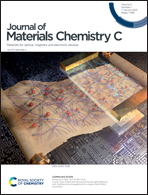Pentacene/non-fullerene acceptor heterojunction type phototransistors for broadened spectral photoresponsivity and ultralow level light detection†
Abstract
ITIC-type non-fullerene acceptors (NFAs) have attracted substantial attention in organic photovoltaics due to their advantages over fullerene derivative molecules. Briefly, the strengthened absorption coefficient, broadened spectral photoresponse, efficient exciton dissociation as well as tunable energy levels of ITIC-NFAs make them competitive components for organic optoelectronics. Here, a high-performance organic phototransistor is displayed using a simple bi-layer heterojunction of pentacene and ITIC. As a high performing semiconductor, pentacene serves as the p-type channel to transport the photo-generated carriers. Meanwhile, the representative NFA molecule, ITIC, is first applied in the organic heterojunction phototransistors (OHPTs) to improve the light detection range by extending the absorption into NIR and to enhance the light detection limit (0.3 μW cm−2). The maximum values of photoresponsivity (R), Iphoto/Idark ratio and external quantum efficiency (EQE) are up to 1.0 × 105 A W−1, 4.7 × 105 and 2.0 × 105%, respectively. The overall performances of our device are among the highest values in all-organic thin-film heterojunction phototransistors. These results demonstrate that ITIC-type NFAs could be highly efficient alternative acceptors for high-performance OHPTs.



 Please wait while we load your content...
Please wait while we load your content...